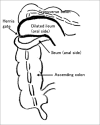Small intestinal strangulation due to a rare type of primary internal hernia
- PMID: 24229032
- PMCID: PMC3829072
- DOI: 10.9738/INTSURG-D-13-00114.1
Small intestinal strangulation due to a rare type of primary internal hernia
Abstract
Internal hernias in which the gate is located in the paracolic gutter are rare. A 75-year-old man was admitted to our hospital with severe epigastric pain without past history of laparotomy and/or trauma. He was diagnosed with strangulation of the ileum by the findings of computed tomography, and the operation was performed. During laparotomy, the small intestine was found to be strangulated and to enter the retroperitoneum from the right paracolic gutter near the hepatic flexure. The patient was diagnosed with an internal hernia, which differed from a pericecal hernia in that the hernia gate was located along the paracolic gutter near the hepatic flexure far from the cecum. Hence, it was considered to be a rare type of internal hernia. We report the clinical presentation and imaging findings of this rare internal hernia.
Figures



References
-
- Ghahremani GG. Internal abdominal hernias. Surg Clin North Am. 1984;64(2):393–406. - PubMed
-
- Rivkind AI, Shiloni E, Muggia-Sullam M. Paracecal hernia: a cause of internal obstruction. Dis Colon Rectum. 1986;29(11):752–754. - PubMed
-
- Ghahremani GG. Abdominal and pelvic hernias. In: Gore RM, Levine MS, editors. Textbook of Gastrointestinal Radiology. 2nd ed. Philadelphia, PA: Saunders; 2000. pp. 1993–2009. In. eds.
-
- Aggarwal BK, Rajan S, Aggarwal A, Gothi R, Sharma R, Tandon V. CT diagnosis of Meckel diverticulum in a paracolic internal hernia. Abdom Imaging. 2005;30(1):56–59. - PubMed
-
- Martin LC, Merkle EM, Thompson WM. Review of internal hernias: radiographic and clinical findings. AJR Am J Roentgenol. 2006;186(3):703–717. - PubMed
Publication types
MeSH terms
Substances
LinkOut - more resources
Full Text Sources
Other Literature Sources
Medical
Miscellaneous

